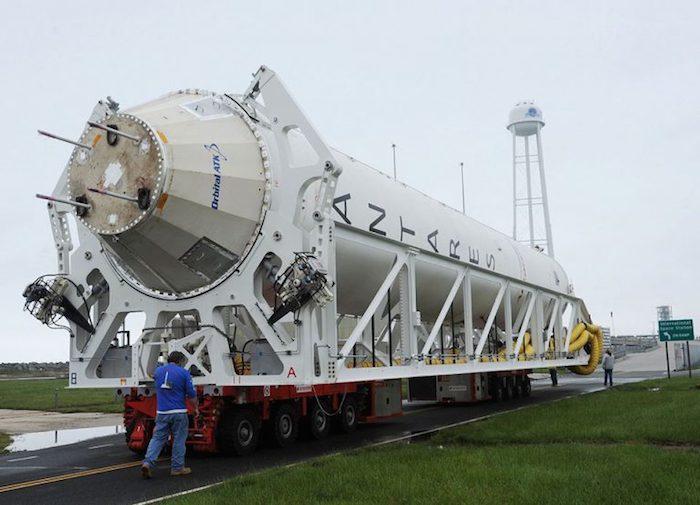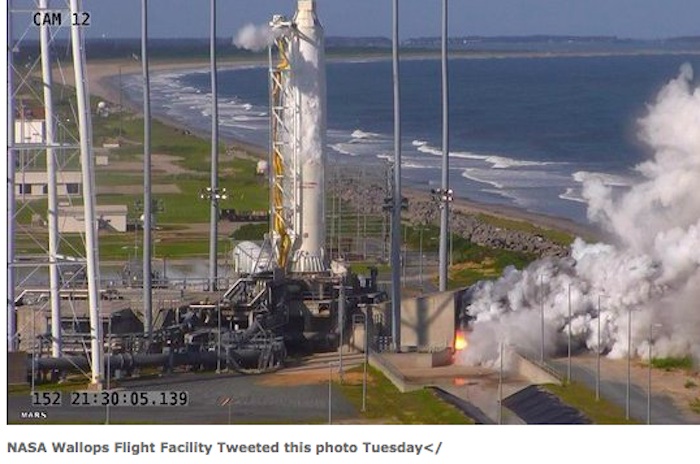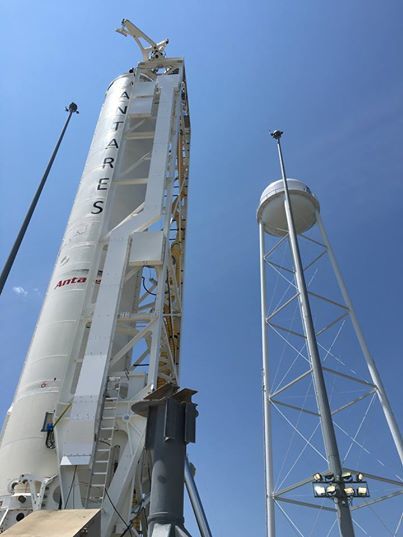.
14.05.2016

Orbital ATK’s Antares first stage with the new engines is rolled from NASA Wallops Flight Facility’s Horizontal Integration Facility to Virginia Space’s Mid-Atlantic Regional Spaceport Pad-0A on May 12, 2016, in preparation for the upcoming stage test in the next few weeks. The team will continue to work meticulously as they begin final integration and check outs on the pad and several readiness reviews prior to the test. The window for the stage test will be over multiple days to ensure technical and weather conditions are acceptable. Photo Credit: NASA/Allison Stancil
-
Nineteen months after suffering a spectacular explosion just seconds after liftoff, Orbital ATK is on the verge of returning their Antares rocket to flight at the Mid-Atlantic Regional Spaceport (MARS) this summer, located at NASA’s Wallops Flight Facility in Virginia. The loss of the ORB-3 mission in October 2014 was blamed on an engine turbopump employed by the rocket’s 40-year-old Soviet-era Russian NK-33 engines (refurbished by Aerojet Rocketdyne and redesignated as the AJ-26), and forced Orbital ATK to make changes to their rocket’s design.
Now, the new and improved version of the original booster is at its launch pad sporting new RD-181 engines, which is the biggest change made to Antares after the original AJ-26 engines proved unreliable (Orbital ATK also had AJ-26 engines fail on a test stand, twice, the latest in May 2014).
The rocket was transported from the company’s Horizontal Integration Facility (HIF) to nearby Launch Pad-0A on May 12, and will be put through a 30-second static hot-fire test on the launch pad in “the next few weeks”, according to Orbital ATK.
“The team will continue to work meticulously as they begin final integration and check outs on the pad and several readiness reviews prior to the test,” added the company in a statement May 12. “The window for the stage test will be over multiple days to ensure technical and weather conditions are acceptable.”
Currently targeting a “Return to Flight” launch date of July 6, the mission will follow the OA-6 mission launched from Florida last March, which was added to the manifest when Orbital ATK decided to purchase a second Atlas-V rocket from United Launch Alliance (ULA) to fly their Cygnus cargo ship to the ISS. Because preparations for OA-5 were already underway when the second Atlas-V launch was ordered, the mission numbers are out of sequence.
Orbital ATK originally planned to use the entire OA-5 vehicle for the hot-fire test before integrating their Cygnus cargo ship. Instead, a separate core stage is being used, which allows for processing of the OA-5 vehicle to proceed in parallel with the upcoming test fire.
The test stage now at Launch Pad -0A will later be refurbished and used to launch the OA-7 mission, scheduled to fly no-earlier-than October, 2016.
In addition to improved reliability over the former AJ-26 engines, the RD-181 will offer a performance boost for Antares. “The RD-181 has a little higher thrust, a little higher specific impulse, which results in about a 20-25% increase in our cargo capacity to CRS orbit.” said Mike Pinkston, Orbital ATK’s Antares Program Manager, during a visit AmericaSpace made to see the Antares 0A-5 and 0A-7 hardware a few months ago.
This, combined with the extra capacity of the enhanced Cygnus, will enable Orbital ATK to deliver up to 3200 kg of cargo to the ISS.
As outlined previously by AmericaSpace reporter Elliot Severn, repairs at the launch pad were completed on Sept. 30, 2015, along with upgrades to support the new Antares configuration. According to Dale Nash, Director of the Virginia Commercial Space Flight Authority: “We completed a performance test of all the new systems in the first week of November. We will continue to run the procedures, do the simulations, and make sure everyone is up to speed and in launch mode to support the hot fire and the return to flight and a pretty busy manifest after that.”
With the launch pad now flight ready, Nash and his team could support a launch with only a few weeks notice. Repairs have been made to the ablative material inside the flame trench after the first hot-fire in 2013 and five subsequent launches took their toll. Having a fresh layer of insulation will be essential for the upcoming hot-fire test.



“The hot fire usually causes more wear and tear because it sits here and dwells for more than 30 seconds.” said Nash. “On a normal launch, it’s no more than a few seconds before it goes away.” These repairs should sustain the pad for the hot-fire and four to five launches in rapid succession.
Meanwhile, the company’s Cygnus cargo ship service module for OA-5 arrived at Wallops this week for processing and integration into an extended pressurized cargo module for July’s Return to Flight, a resupply mission to the ISS for NASA. The service module holds all of the avionics, electrical, propulsion and communications systems for the ship.
Together with SpaceX, Orbital ATK has contracts from NASA to provide resupply services to the ISS. Under the original $1.9 billion contract, signed in December 2008, Orbital Sciences Corp. was tasked with delivering 44,000 pounds (20,000 kg) of equipment and supplies on eight dedicated Cygnus missions, to be flown by 2016. Following an initial demonstration mission to the station in the fall of 2013, Orbital flew two of those dedicated missions in January and July 2014, before the loss of ORB-3 the following Oct.
In early 2015, Orbital merged with parts of Alliant Techsystems (ATK) to become “ATK Thiokol” and in December returned the Cygnus to flight with the newly-renamed OA-4 mission. The remainder of the original eight flights remain on the books, although the recently-trialed Enhanced Cygnus—which benefits from a larger payload capacity than its predecessor, the Standard Cygnus—was expected to allow Orbital ATK to complete its original commitment to NASA in seven missions.
Last August, NASA awarded the company three more Enhanced Cygnuses through the end of 2018, which will loft a combined total of 59,000 pounds (26,800 kg) of equipment and supplies to the ISS. More recently, in January 2016, Orbital ATK was selected for the follow-on NASA CRS-2 contract, which will guarantee the company at least six more Enhanced Cygnus missions between 2019 and the currently timetabled end of ISS operations in December 2024.
Quelle: AS
.
Update: 1.06.2016
.
UPDATE: NASA conducts "hot fire" rocket engine test at Wallops

NASA Wallops Flight Facility Tweeted this photo Tuesday
NASA scientists are reviewing the results of Tuesday's test of the engine for an Orbital ATK Antares 230 rocket at Wallops Flight Facility on Virginia's Eastern Shore - what's known as the "hot fire" test.
The engines were set to fire for 30 seconds at maximum power while the rocket stayed in place on the pad.
According to NASA, the test is a "key milestone" leading up to the next Antares rocket flight, which is scheduled for later in the summer. and demonstrates readiness of the rocket's first state and the ability "of the launch pad fueling systems to support upcoming flights."
Quelle: DELAWARE 105.9
.
Antares engine test shakes ground near Wallops Island

WALLOPS ISLAND, Va. (WAVY) — Did you feel tremors Tuesday afternoon?
Several 10 On Your Side viewers reported feeling a rumbling under their feet, similar to an earthquake.
NASA’s Wallops Island Flight Facility completed a hot fire test for an Antares medium-class rocket on Tuesday. The 30-second test took place at 5:30 p.m. at Virginia Space’s Mid-Atlantic Regional Spaceport Pad 0A.
The test was fully successful, according to initial indications. The Antares engineering team will review test data over the next two weeks to confirm that all test parameters were met.
“Early indications show the upgraded propulsion system, core stage and launch complex all worked together as planned,” said Mike Pinkston, Orbital ATK General Manager and Vice President, Antares Program.
The engine test helps determine the rocket’s readiness for its first stage as well as the launch pad fueling systems’ ability to support upcoming flights.
The test is a key milestone leading up to the next flight of the Antares rocket, which is targeted for later this summer. The Orbital ATK to resume cargo resupply services to the International Space Station from NASA’s Wallops Island Flight Facility.
.

Wallops Flight Facility will provide launch range support for an Orbital ATK Antares 230 rocket first stage test scheduled for May 31 at the Mid-Atlantic Regional Spaceport's Pad-0A.
The window for the engine test, or hot fire, is 5 p.m. to 8:15 p.m. EDT. Backup test dates run through June 5.
During the test, the upgraded Antares dual RD-181 rocket engines will fire for 30 seconds at maximum 100% power (thrust) while the first stage of the test rocket will be held down on the pad. The hot fire will demonstrate the readiness of the rocket's first stage and the launch pad fueling systems to support upcoming flights.
The test is a key milestone leading up to the next flight of the Antares rocket, which is targeted for later this summer.
The test will be visible and audible in the Wallops Island local area. Given the broad window and non-operational nature of the test, no live webcast or formal public viewing is planned. Completion of the test will be noted here and on Twitter, @NASA_Wallops.
Quelle: WAVY-TV
-
Re-engined Antares rocket completes ground test firing
Orbital ATK’s upgraded Antares rocket, featuring newly-built RD-181 main engines, completed a 30-second test firing on a launch pad on Virginia’s Eastern Shore on Tuesday.
The hotfire test is a key step before the Antares rocket returns to flight in July, resuming cargo service to the International Space Station from Virginia.
Working from a control center several miles away at NASA’s Wallops Flight Facility, the Antares launch team oversaw filling of the rocket’s Ukrainian-made core stage with kerosene and liquid oxygen propellants Tuesday. A computer-controlled sequencer took over the final stages of the countdown, which concluded with ignition of the rocket’s two RD-181 engines at 5:30 p.m. EDT (2130 GMT).
Hold-down restraints at pad 0A at the Mid-Atlantic Regional Spaceport, a state-owned facility on Wallops Island, kept the Antares vehicle firmly grounded for the test firing.
Engineers plan to review data from the hotfire test in the coming days to ensure all systems performed as designed before Orbital ATK resumes Antares cargo launches to the International Space Station in July.
“Early indications show the upgraded propulsion system, core stage and launch complex all worked together as planned,” said Mike Pinkston, Orbital ATK’s general manager and vice president for the Antares program. “Congratulations to the combined NASA, Orbital ATK and Virginia Space team on what appears to be a successful test.”
The hotfire test Tuesday came after a successful wet dress rehearsal May 22, in which the launch team loaded propellants into the rocket but halted the countdown before ignition of the main engines.
Tuesday’s hotfire demonstrated several operational launch procedures, Orbital ATK said, including the full propellant loading sequence, launch countdown, engine ignition and shutdown commands, as well as multiple throttle settings.
Ground crews will remove the Antares test vehicle, which comprises just the first stage of the two-stage launcher, from pad 0A in June and roll it back to Orbital ATK’s rocket processing hangar, where it will be readied for a mission scheduled later this year.
A separate booster inside the Horizontal Integration Facility at Wallops is assigned for the next Antares launch — the first flight of the medium-lift rocket since an explosive mishap moments after liftoff in October 2014 destroyed a space station supply ship and damaged the seaside launch pad.
The engine firing Tuesday tested the launch pad’s repairs, such as the fueling and water deluge systems.
“Orbital ATK will now purge and clean the engines of residual propellants and return the first stage used in this test to the Horizontal Integration Facility for full reconditioning prior to its use on the OA-7 mission slated for later this year,” the company said in a statement. “The Orbital ATK team will continue to prepare the Antares rocket that will launch the OA-5 mission, which is in the final stages of integration, systems testing and check-out in preparation for launch this summer.”
The OA-5 mission is tentatively scheduled for liftoff July 6 at around 12:49 p.m. EDT (1649 GMT), when the Antares booster will send Orbital ATK’s Cygnus commercial cargo craft to the International Space Station. An official target launch date will be set by Orbital ATK and NASA after the data review following Tuesday’s hotfire test.
“The successful stage test, along with the extensive testing of each new RD-181, gives us further confidence in the first stage propulsion and in moving forward to launch,” Pinkston said in a statement. “We are now focused on the OA-5 mission and launching the enhanced Cygnus spacecraft to the International Space Station on our upgraded, higher-performing Antares rocket.”
After the 2014 launch failure, Orbital ATK accelerated plans to replace the Antares rocket’s AJ26 engines, which were built more than 40 years ago for the Soviet-era N1 moon rocket, with newly-manufactured RD-181 engines from NPO Energomash of Moscow.
Orbital ATK’s investigation blamed the 2014 rocket crash on a decades-old manufacturing defect in the liquid oxygen turbopump of one of the AJ26 engines.
The first pair of new RD-181 engines arrived at the Virginia launch base from Russia in August 2015, followed by a second set in December. Another shipment of engines is due soon.
During Tuesday’s test, the engines were programmed to fire up to full power — equivalent to more than 800,000 pounds of combined thrust — and go through a steering check as the control computers throttled the engines to different thrust levels they will see in flight.
The Antares rocket’s new propulsion avionics package, made in-house by Orbital ATK for the RD-181 to replace an engine controller previously made by Moog, was also put to the test during Tuesday’s hotfire.
The RD-181 engines are about the same size as the AJ26s it replaces, minimizing changes to the launch pad mount and the first stage structure. Engineers designed a new apparatus to connect the RD-181 engines to the stage.
“The new components were the engines, obviously, the new thrust adapter, and then feedlines, which are the pipes that connect the core tanks to the engines, and then some new avionics and software to control it all,” said Kurt Eberly, Orbital ATK’s deputy Antares program manager, in an interview earlier this year. “That was really what changed. Everything forward of the first stage is identical.”
The RD-181 engines produce more thrust and burn more efficiently than the AJ26 engines, giving the upgraded Antares the ability to lift heavier cargo into orbit.
The new Antares configuration, called the Antares 230, can haul up to 15,400 pounds (about 7,000 kilograms) into the International Space Station’s orbit, according to John Steinmeyer, director of strategy and business development for Orbital ATK’s launch vehicle division.
That is an increase over the 12,800-pound (5,800-kilogram) payload capacity of the Antares rocket with AJ26 engines.
Those figures encompass the entire weight of the Cygnus spacecraft, not just the cargo packed inside.
In the wake of the 2014 launch failure, Orbital ATK purchased two Atlas 5 rocket flights from United Launch Alliance to carry Cygnus supply ships to the space station in December 2015 and March, continuing the company’s execution of a more than $2 billion contract covering 11 logistics missions to the outpost.
The OA-5 mission set for launch in July will be the sixth of 11 operational space station cargo runs planned by Orbital ATK under an extended contract first signed with NASA in 2008. Orbital ATK won a contract for another batch of at least six additional resupply flights earlier this year.
Quelle: SN
4253 Views
